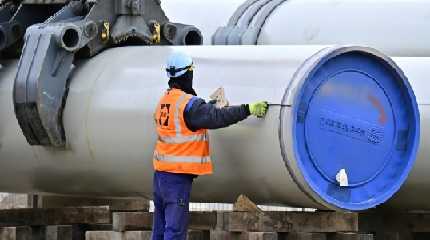
WARSAW, Poland (AP) — Explosions rattled the Baltic Sea before unusual leaks were discovered on two natural gas pipelines running underwater from Russia to Germany, seismologists said Tuesday. Some European leaders and experts are pointing to possible sabotage during an energy standoff with Russia provoked by the war in Ukraine.
The three leaks on the Nord Stream 1 and 2 pipelines, which are filled with natural gas but not delivering the fuel to Europe, overshadowed the inauguration of a long-awaited pipeline that will bring Norwegian gas to Poland to bolster the continent’s energy independence from Moscow.
The first explosion was recorded early Monday southeast of the Danish island of Bornholm, said Bjorn Lund, a seismologist with Uppsala University who is part of Sweden’s national seismic network. A second, stronger blast northeast of the island that night was equivalent to a magnitude-2.3 earthquake. Seismic stations in Norway and Finland also registered the explosions.
“There’s no doubt this is not an earthquake,” Lund said.
The gas leaks created a foamy white area on the water’s surface, images released by Denmark’s military show.
Polish Prime Minister Mateusz Morawiecki called the events “an act of sabotage,” while Danish Prime Minister Mette Frederiksen said she could not rule it out. They and Polish President Andrzej Duda symbolically opened a valve of a yellow pipe belonging to the Baltic Pipe, a new system that will bring Norway’s gas across Denmark and the Baltic Sea to Poland.
“The era of Russian domination in the gas sphere is coming to an end,” Morawiecki declared. “An era that was marked by blackmail, threats and extortion.”
No official presented evidence of what caused the Nord Stream problems, but with distrust of Russia running high, some feared Moscow sabotaged its own infrastructure out of spite or to warn that pipelines are vulnerable to attack. The leaks in international waters off the coast of Denmark and Sweden raised the stakes on whether energy infrastructure was being targeted and led to a small bump in natural gas prices.
“We can clearly see that this is an act of sabotage, an act that probably means a next step of escalation in the situation that we are dealing with in Ukraine,” Morawiecki said.
U.S. Secretary of State Antony Blinken told reporters that American officials have not confirmed sabotage or an attack.
Anders Puck Nielsen, a researcher with the Center for Maritime Operations at the Royal Danish Defence College, said the timing of the leaks was “conspicuous” given the ceremony for the Baltic Pipe. He said perhaps someone sought “to send a signal that something could happen to the Norwegian gas.”
The extent of the damage means the Nord Stream pipelines are unlikely to be able to carry any gas to Europe this winter even if there was political will to bring them online, analysts at the Eurasia Group said. Russia has halted flows on the 1,224-kilometer (760-mile) Nord Stream 1 pipeline during the war, while Germany prevented them from ever starting in the parallel Nord Stream 2.
“Depending on the scale of the damage, the leaks could even mean a permanent closure of both lines,” analysts Henning Gloystein and Jason Bush wrote.
They noted that undersea pipelines are designed in a way that they are not accidentally damaged and leaks are rare.
Puck Nielsen said of possible sabotage that “technically speaking, this is not difficult. It just requires a boat. It requires some divers that know how to handle explosive devices.”
“But I think if we look at who would actually benefit from disturbances, more chaos on the gas market in Europe, I think there’s basically only one actor right now that actually benefits from more uncertainty, and that is Russia,” he said.
Asked if the leaks may have been caused by sabotage, Kremlin spokesman Dmitry Peskov said “no version could be excluded.”
“This is an unprecedented situation that requires an urgent investigation. We are extremely worried by this news,” he said in a conference call with reporters.
The Danish and Swedish maritime authorities issued navigation warnings. On the eastern coast of Bornholm, the Danish Emergency Management Agency installed equipment that measures the concentration of gas in the air. Local police said “authorities assess that there are no safety or health risks.”
Denmark also established a prohibited area to ensure that ships avoid the leaks. Ships may lose buoyancy, and there may also be a risk of ignition above the water and in the air, authorities said.
The Nord Stream pipelines have been at the center of an energy clash between Europe and Russia since the invasion of Ukraine in late February. Plunging Russian gas supplies have caused prices to soar, pressuring governments to help ease the pain of sky-high energy bills for households and businesses as winter nears. The crisis also has raised fears of rationing and recession.
The Baltic Pipe is a prominent element in the European Union’s search for energy security and is to start bringing Norwegian gas through Denmark and along the Baltic Sea to Poland on Oct. 1.
Simone Tagliapietra, an energy expert with the Bruegel think tank in Brussels, speculated that the leaks could have been caused by Russian sabotage or anti-Russian sabotage.
One possibility is Russia signaling it “is breaking forever with Western Europe and Germany” as Poland inaugurates its pipeline with Norway, he said.
“In any case, this is a stark reminder of the exposure to risk of Europe’s gas infrastructure,” Tagliapietra said.
Andrzej Sikora, the head of the Energy Studies Institute think tank in Poland, said he has been warning of the possibility of attacks on pipeline infrastructure since the construction of Nord Stream 1 in 2010. He has been urging steps to ensure the security of the Baltic Pipe, which at one point crosses paths with both Nord Stream pipelines.




